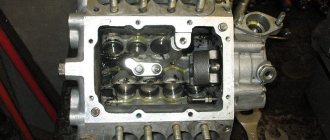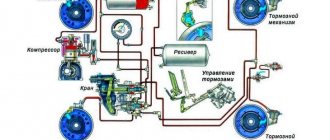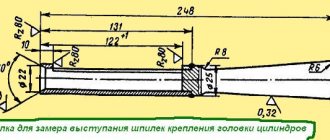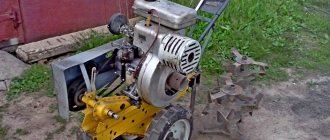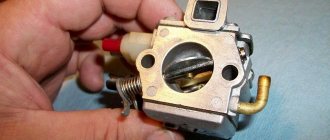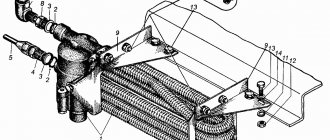Cummins engines, which are now installed on KAMAZ vehicles, are very reliable and have a long service life. They require mandatory regular maintenance. Among other things, periodic adjustment of KAMAZ valves is extremely important. The automaker's official instructions indicate that valve adjustment in KAMAZ vehicles with a Cummins engine should be carried out after a minimum of 240,000 km. But, in addition to performing planned work, the need for it may arise for other reasons.
The first signs indicating that adjustment of the KAMAZ internal combustion engine valves is necessary is a knocking sound that occurs under the hood, an increase in the “appetite” of the power plant or a decrease in its power. Ignoring these signs and lack of timely valve adjustment leads to the fact that subsequent use of the engine may lead to new malfunctions in the internal combustion engine. Therefore, it is worth knowing the procedure for adjusting KAMAZ valves yourself.
Why is valve adjustment done?
Engine operation inevitably causes increasing imbalance of working units and parts. This occurs both as a result of normal operation and violations of the operating rules of diesel units. The result is deviations in valve clearances from the optimal value.
Prolonged operation of an engine that shows signs of malfunction accelerates its wear and potentially threatens more serious breakdowns, including complete failure of the unit. Before adjusting the valve clearances, the reasons that caused the imbalance should be eliminated. Otherwise, the malfunction will appear again soon. The main reasons are:
- previously incorrectly adjusted clearances and errors when tightening bolts in
- cylinder head;
- physical wear or other failures in timing units;
- the use of low-quality coolant, which caused engine overheating;
- air pollution;
- engine oil contamination;
- breakdowns associated with incomplete combustion of fuel;
- excessively long operation at high speeds;
- abuse of starting the engine using ether.
Clear signs that the engine requires immediate maintenance are a metallic knocking sound in a running unit, increased fuel consumption and a drop in unit power.
Even if there were none of the above incidents, every 150-200 thousand kilometers it is necessary to adjust the valves simply for preventive purposes.
Features of operation and service maintenance of KAMAZ-5490
By the way, not very many tractors with a mileage of over 300 thousand km are serviced and repaired in service centers. Just don’t think that after this run the KAMAZ-5490 stops breaking down altogether and doesn’t require changing the oil, filters, brake pads and steering ends. The fact is that by this time most carriers' leasing period ends and you can save money by refusing service from a dealer or a certified service center. A well-known story... This doesn’t seem to be very good, but there are a couple of interesting points here. Firstly, even “gray” service centers or the company’s own technical service have already mastered the maintenance and repair of 5490 trucks. Secondly, spare parts can be purchased not only from dealers. But let’s not suspect carriers of deliberately “ruining” cars without servicing them. Surely, most managers have in their heads a truck mileage limit beyond which they plan to sell the car. Most likely, it is 800 thousand km, closer to a million. And it won’t be possible to drive another 600-700 thousand on hard “counterfeit” spare parts without maintenance. So, in total, it turns out that the KAMAZ-5490 service has already been completely improved. Andrei Vlasov, director of the service station of TSK TECHINCOM CJSC, answers questions from the editors of Reis magazine about the operation of the engine, gearbox and other components and systems, features of vehicle maintenance and repair
– – one of the largest dealers of the Kama Automobile Plant in Russia. How many KAMAZ-5490 truck tractors are serviced per year at the Moscow service center? What version do these trucks most often come in? What, according to your estimates, is the average annual and maximum mileage of cars?
– On average, CJSC TSK TECHINCOM services about 250 KAMAZ-5490 vehicles from different transport companies per year. The most common configuration is with Daimler OM457 engines with a power of 428 hp. pp., both with manual and automatic ZF gearboxes. Cabins are standard, high, with sleeping bags. Cars are serviced from zero mileage to approximately 300-400 thousand kilometers. According to our statistics, the average annual mileage is about 120,000 km.
– When did your company start servicing KAMAZ-5490? Where are these trucks typically operated?
– The first cars entered service in 2015. They are used in Russia, mainly for interregional transport.
– How difficult was the maintenance and repair of the new KAMAZ? After all, it has practically nothing in common with previous models.
– At the initial stage, there were difficulties in servicing these cars, in diagnosing the brake system and electronic engine systems. There were also “childhood diseases”. But the car plant conducted intensive training for dealers and repairmen, and gradually we gained experience. Now we are waiting for deliveries of the newest KAMAZ-54901, that is, the K5 generation vehicle. We hope that we will quickly master these tractors as well.
– What are your impressions of the experience of operating in-line 12-liter OM457 engines on KAMAZ-5490?
– The OM457 engine has proven itself to be a reliable unit even in the Mercedes-Benz Axor. A completely modern and economical diesel engine, quite easy to maintain and repair. Installing this engine on the KAMAZ-5490, in the opinion of most carriers, was the right decision.
– Initially, on KAMAZ-5490, in addition to Daimler OM457 engines, it was planned to use KAMAZ-740.70 engines with a power of 400 hp. With. In your opinion, does it make sense to use traditional “eights” on KAMAZ-5490, but in a modern version, for regional transportation?
– I consider the use of KAMAZ V8 engines in regional transportation inappropriate. The OM457 inline six is more economical and reliable, and better balanced.
– Are there any special features of operating the fuel system on OM457 engines?
– On OM457, the entire fuel system is made by Bosch, and therefore well-functioning, reliable, and of high quality. There are no special problems either in the electronic part or in the hydraulic part - with precision pairs. The PLD system itself with a mini-fuel injection pump and electronic control has proven itself very well in Russia. There were isolated cases of leakage of the sealing rings of sections, which were quickly corrected under warranty. The use of additional fuel sediment filters of the Separ type is very useful. The quality of diesel fuel in Russia has improved over the past 15 years, but you can still grab water when refueling. Therefore, Separ is a very necessary filtration system. With regular draining of condensate, it extends the life of the entire fuel system. The only thing is that the drain valve is not very convenient; drivers sometimes break it off.
– The KAMAZ-5490 uses an original, specifically for KAMAZ, radiator of the cooling system. Is it effective enough? Were there any problems with the engines overheating or with the quality of the radiator itself? How reliable is the electromagnetic fan clutch?
– The cooling radiator is reliable and effectively copes with its task. Problems arise when maintenance is untimely due to the honeycomb becoming clogged with lint and road dirt. There is only one solution, which has long been known - to periodically rinse and blow with compressed air the surface of the radiator. However, the process of cleaning a heavily contaminated radiator is inconvenient for drivers: it is necessary to dismantle the radiator unit along with the intercooler. According to our observations, the fan clutch is reliable.
– What engine oil is used in OM457 engines when operating in central Russia? How often should you change your oil?
– For these engines we use Shell Rimula R6 ME synthetic motor oil with a viscosity index of 5W-30 (E4, 288.5) with API CF approval code. The frequency of replacement depends on the category of use. Basically, for long-haul tractors this is 60,000 km.
– How easy is it to start engines during winter operation in Russia? Do you need preheating from a liquid “autonomy”? At what temperature do motors start without heating?
– A guarantee of a confident start of the OM457 diesel engine in winter is the use of synthetic motor oil with a viscosity of 5W-30, high-quality winter fuel, serviceable glow plugs and reliable, fully charged batteries. In this case, the engine starts successfully without using a pre-starting liquid heater in temperatures down to –30 degrees.
– What is the frequency of valve adjustment in the engine?
– During the initial period of operation of the KAMAZ-5490, as well as the Mercedes-Benz Axor with the OM457 engine, problems arose with increased wear of the pushers and camshaft. To eliminate it, the regulation for adjusting the thermal clearances of the valves was changed. Now the adjustment is carried out every 60 thousand km, that is, at every periodic maintenance. Previously, it was prescribed to adjust the valves after 120,000 km.
Procedure for adjusting valves on a Cummins 6ISBe engine
You should start servicing the engine only if the coolant temperature does not exceed 60 degrees. Adjusting a hot engine is prohibited.
To gain access to the valves themselves, you need to remove the rocker cover from the engine. For this purpose, first disconnect the crankcase breather, starting from the oil drain line fitting. Next, disconnect the breather tube fitting from the cover, while also removing it from the rear camshaft housing. To perform this procedure, loosen the clamp on the breather tube and remove the fitting. Now the rocker cover can be easily removed along with the gasket.
Having done this, we get direct access to the crankshaft. It must be turned by setting the piston of the first cylinder at top dead center. This position is determined in the following way: that part of the speed sensor ring on which there are no grooves should be at the top at 12 o’clock. If the rocker arms do not release, turn the crankshaft a full revolution.
Next comes the most important stage - measuring and adjusting the gaps. It is necessary to determine the rocker arm clearances on both the exhaust and intake valves. At the inlet it should be 0.25 mm , and at the outlet - 0.5 mm .
The correctness of the set gap is most easily determined using a feeler gauge. It should fit into the space between the crosshead and the rocker seat with some resistance. If the feeler gauge enters too freely, too difficultly, or does not enter at all, then the gap is set incorrectly. To adjust it, unscrew the lock nut and use a special adjusting screw to set the desired position. Re-checking is carried out only after the locknut is tightened back.
By turning the crankshaft, all other engine valves are adjusted according to the same scheme. Having finished with the adjustment, you should reinstall the gasket and rocker cover. In this case, you should pay attention to the gasket. If it is deformed or cracked, it should be replaced with a new one.
Cummins engines, which are now installed on KAMAZ vehicles, are very reliable and have a long service life. They require mandatory regular maintenance. Among other things, periodic adjustment of KAMAZ valves is extremely important. The automaker's official instructions indicate that valve adjustment in KAMAZ vehicles with a Cummins engine should be carried out after a minimum of 240,000 km. But, in addition to performing planned work, the need for it may arise for other reasons.
Why does valve imbalance occur?
It is necessary to realize that adjusting KAMAZ valves with your own hands is useless if the original cause of the malfunction is not eliminated. Possible causes are breakdowns that are associated with improper or not carried out on time maintenance:
- incorrect setting of valve clearances or incorrect sequence of tightening bolts on the cylinder head during preliminary engine maintenance;
- physical wear or malfunction of timing parts;
- the use of low-quality cooling fluid, which led to overheating of the engine;
- a faulty air filter that allows not only air but also dirt to enter the cylinders;
- the use of contaminated or low-quality motor oil, untimely replacement of the filter or the oil itself;
- fuel that does not burn completely due to other breakdowns or poor quality of the fuel itself.
Procedure for adjusting KAMAZ valves with a Cummins engine: clearances
The procedure for adjusting KAMAZ valves and the procedure for adjusting KAMAZ valves with a 6-cylinder Cummins engine do not differ from each other.
Adjusting KAMAZ Euro-4 valves involves first removing the rocker cover from the engine. To do this, you need to disconnect the crankcase breather from this cover. First, remove the oil drain lines from the breather.
Then it is necessary to disconnect the fitting related to the breather tube from the back side of the cover of these rocker arms, then it is removed from the rear camshaft housing. To do this, it is necessary to loosen the clamp attached to the breather tube, then pull the fitting in a vertical direction. Then, to provide access to the valves, you need to remove the rocker cover with gasket.
KAMAZ Euro-1 valves are adjusted when the temperature of the cooling fluid does not exceed 60 degrees. Any KAMAZ valve adjustment scheme implies this.
After turning the crankshaft, you need to establish the dead top point of the piston of the 1st cylinder of the engine.
On an engine that does not have a system that recirculates used gases, the top dead center is set as follows: a sensor ring indicating the engine speed is placed so that the part without grooves is at 12 o’clock.
In the case when both rocker arms on the first cylinder are not released for adjustment, it is necessary to rotate the crankshaft, making a full revolution.
KAMAZ Euro-3 valve adjustment diagram
On an engine on which a used gas recirculation system is installed, the location of the dead top point of the 1st cylinder is a torsional vibration damper or a sensor ring indicating the engine speed.
It is necessary to install the ring or damper so that the mark is at 12 o'clock.
If it was not possible to release the rocker arms of the 1st cylinder, you still need to rotate the crankshaft 360 degrees. Then you can start measuring the valve and rocker clearances.
This is exactly the sequence of adjusting KAMAZ valves.
Valve clearances for KAMAZ engines with Cummins engines
In this position of the crankshaft, the clearances of the following rocker arms are measured:
- E – exhaust valve, I – inlet valve;
- for engines with 14 cylinders: 1E, 1I, 2I, 3E;
- for engines with 16 cylinders: 1E, 1I, 2I, 3E, 4I, 5E.
The maximum intake valve clearance is 0.381 mm, the minimum is 0.152 mm, for the exhaust valve the minimum clearance is 0.381 mm, the maximum is 0.762 mm.
The clearance is set correctly if the feeler gauge passes between the crosshead and the rocker socket and encounters only slight resistance.
General information
Adjustment of the valve mechanism is carried out only at the intervals specified in the Operation and Maintenance Manual (Owner's Manual), or in the case when, when repairing the engine, it is necessary to remove the rocker arms and (or) unscrew the adjusting screws.
A premature increase in valve clearance indicates improper adjustment after a previous repair, wear of valve stems, crossheads, pushrods or rocker arms*.
Free movement of the rocker arms and the need to frequently adjust the valve clearance may also indicate wear on the camshaft cams or tappets. If no wear is found on the rocker arms, valve stems, crossheads, or pushrods, the pushrods and/or camshaft lobes may be worn.
Bosch Common Rail fuel equipment.
One of the most discussed topics is fuel equipment. Cummins 4ISBe and 6ISBe engines are equipped with Bosch Common Rail fuel equipment. These Euro-3 engines have BOSCH injectors under serial numbers 4937065 (by Bosch 0445120123)
These engines have a high pressure fuel pump 5264248, 4988595, 4982057, 3971529.
Fuel rail (rail) 3977530, BOSCH catalog number 445226042 (0 445 226 042)
Euro-4 engines are equipped with slightly different injectors and injection pumps, but the operating principle is the same.
Most problems associated with the fuel system come down to poor quality fuel. Based on numerous reviews and stories from owners, the problems of failure of injectors and injection pumps are solved by introducing strict control over fuel quality. It is also recommended to install GPS tags to track “unscrupulous” drivers who drain high-quality diesel fuel and fill it with “slop” instead.
The second common cause of breakdowns of injectors and injection pumps is saving on filter elements. The fuel filter must be changed no more than once every 15,000 km. We recommend installing only original Fleetguard filters and not saving money by buying dubious analogues. And the savings are insignificant, and the costs of replacing injectors and injection pumps are quite considerable.
Additionally, installing an additional Separ 2000/10 separator will help protect the fuel system from water and dirt in the fuel. It will not save your internal combustion engine if you refuel with very poor quality fuel, but this separator will filter out 99% of water and dirt particles that may enter the tank.
Signs of a faulty injector.
A symptom of injector failure is the appearance of thick black smoke. This indicates a “pouring” injector or a malfunction of several injectors at once. If black smoke appears, we recommend that you immediately stop using the vehicle and diagnose the fuel equipment. Otherwise, due to excess fuel and the resulting very high temperature in the combustion chamber, the piston may melt, which will lead to the need for major repairs.
Other common signs of injector failure are engine knocking, floating/high engine speeds when idling, decreased power, inability to start the engine except with a tow.
Here are the consequences of a week's operation of an internal combustion engine with pouring nozzles:
The result of such operation is a major overhaul of the engine with the replacement of the entire piston group and the cylinder block liner.
In addition to low-quality fuel, water and dirt, the fuel system can be damaged if there is air in the system and you try to start the engine “dry”. The fuel pump elements are lubricated only with diesel fuel and therefore, if there is air in the system, lubrication becomes insufficient, friction increases and metal shavings can form, which clog the injector nozzles.
One of the stupidest misconceptions is the advice of “experienced specialists” on adding motor oil to diesel fuel, which is supposedly dry and has insufficient lubricating properties. This advice does not apply to Cummins engines and, at best, it will not do any harm. And in most cases it will only accelerate the failure of the fuel system. If engine oil enters the combustion chamber, it will coke during combustion and form carbon deposits on the nozzles, which will ultimately lead to jamming of the nozzle needle and damage to the injector. Next, either repair the nozzle with replacement of the nozzle, or a new nozzle.
Violation of the combustion process
Valve overload due to combustion disturbance
Cause: Due to disruption of the combustion process, significant temperature and pressure loads occur in the combustion chamber.
Consequence: The valve head cannot withstand the strong thermomechanical load and bends inward. It takes on a so-called tulip shape and breaks.
Keywords :
Product groups:
LOADING
- Damage to valves and their causes (50003976-09)
Register to receive the newsletter
Search for traders
online catalog
Product groups on ms-motorservice.com
Valves and related parts
This might interest you too
Usage information
Valve guides
Practical advice on replacement and repair
MS Motorservice International GmbH Wilhelm-Maybach-Straße 14-18 74196 Neuenstadt Germany
Tel: +49 (0) 7139 / 9376 - 33 33 Fax: +49 (0) 7139 / 9376 - 28 64
Use of cookies and data protection
The Motorservice Group uses cookies on your device in order to optimally design and continuously improve its web pages, as well as for statistical purposes. Here you will find further information about the use of cookies, our Imprint and Privacy Notice.
By clicking "OK" you confirm that you have accepted the information about cookies, the data protection declaration and the imprint. You can change your cookie preferences for this website at any time [link]
Wear of piston rings.
As with any other engine, the piston rings on the Cummins 6ISbe will wear out sooner or later. This process can be significantly accelerated if you forget to change air filters in a timely manner, save money and not change the filter, but blow it out, if you do not change the oil and oil filter in a timely manner.
You also need to monitor the air filter housing; sometimes it does not close tightly and dust gets in through the gaps formed.
If you do experience dust wear, we recommend replacing the pistons in addition to the rings, because dust can accumulate and cut into the grooves on the pistons. And the subsequent installation of new rings on old pistons will not last long, because... the rings will wear off in these very grooves.
Incorrect processing
Valve seat guide or ring misalignment
Cause: During rework, the valve seat or valve guide was not centered correctly.
Consequence: The valve does not close properly, overheats and burns in the seat area. Due to the one-sided load on the valve head, fatigue fractures in the fillet area are also possible.
Valve guide clearance too large
Cause: The clearance in the valve guides is too large because they are badly worn or were reamed too wide during repairs.
Consequence: Due to the breakthrough of hot gases, severe carbon formation in the area of the rods and guides is possible. The valve travel becomes heavy, the valve no longer closes, and this leads to overheating (burning, melting) of the seat surface.
Valve guide clearance too small
Cause : When rebuilding the valve guides, the diameter of the guides was incorrectly measured and turned out to be too small.
Consequence: Lack of lubrication, heavy movement and jamming of the valve stem in the guide. This may also result in overheating in the valve head or seat area.
Adjusting Cummins 6ISBe valves and marks.
We recommend adjusting the valves at least once every 150,000 km. During operation, valve clearances increase, which can lead to metallic knocking in the engine, increased fuel consumption and loss of traction. Over time, the valves can “reach” the piston or break the seats and guides of the cylinder heads.
To adjust the valves, turn the crankshaft until the rocker arms of the intake and exhaust valves of the first cylinder are “free”.
Next, on each of the rocker arms there is an adjusting screw with a lock nut. Loosen this locknut and slightly unscrew the adjusting screw. On the other side of the rocker there is a small barrel - * a nickel *, which presses on the crosshead (small valve rocker).
We take the feeler gauge and insert it between this nickel and the crosshead (small rocker arm). Screw in the adjusting screw and tighten the locknut. And so on on all cylinders. Gap at inlet 0.25 at outlet 0.5
Marks: chamfered tooth on the crankshaft gear and dot on the camshaft gear.
Installing the piston of the first cylinder at TDC
When cranking the engine, you can observe how the rocker arms press on the valves. And how the valves open and close. It is necessary to crank the engine until the valves of the first cylinder, Intake and Exhaust, are closed when cranking the crankshaft. The piston moves upward, but the rocker arms are stationary. At the moment when the rocker arms stop moving, it is necessary to set the mark located on the pulley vertically upward. Or if you look at the end of the pulley at 12 o'clock.
The mark is indicated by the letters TDC . And it looks like this.
If you pay attention to the movement of the valves of the sixth cylinder. The piston of the sixth cylinder, just like the first, reaches top dead center
You can see that when the piston of the sixth cylinder moves to TDC, the exhaust valves will close. The inlets are in a closed, stationary state. If that's the case. The piston of the first cylinder is in the compression stroke. And the sixth piston is in the exhaust gas emission stroke. After setting the 12 o'clock mark, you can begin to adjust the valves.
